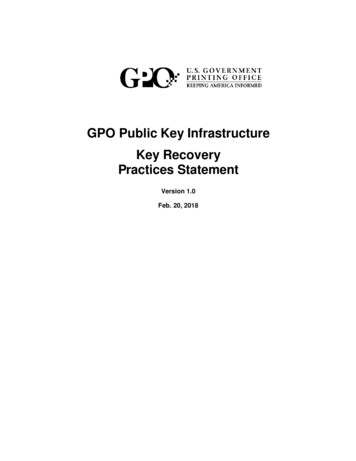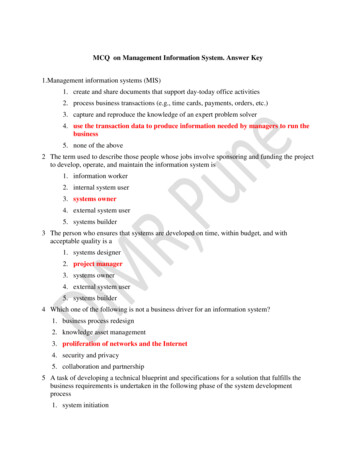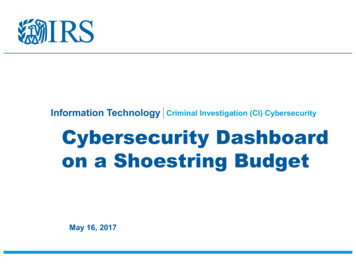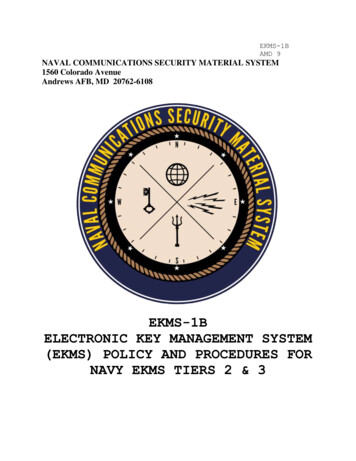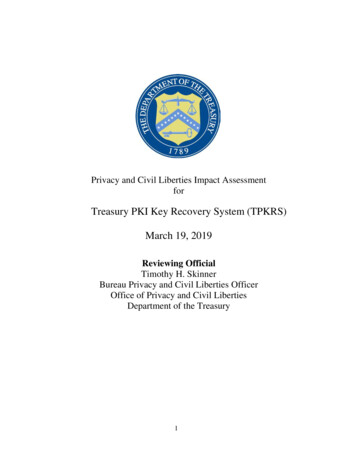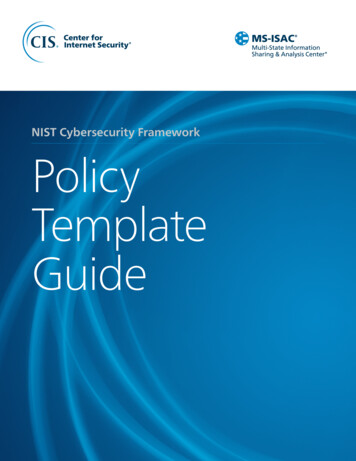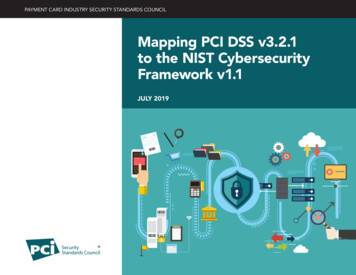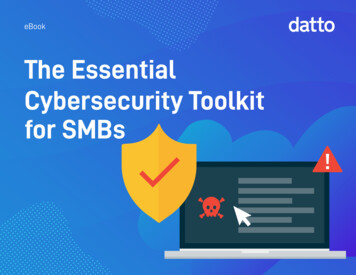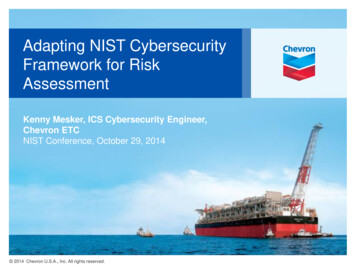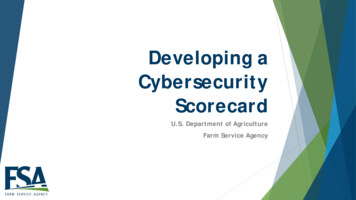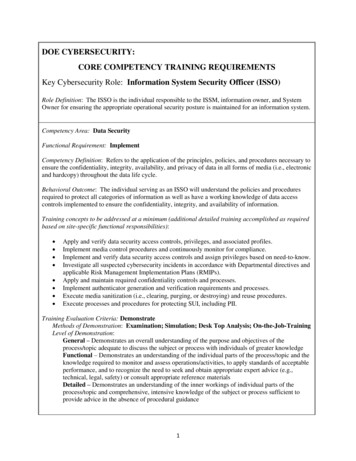
Transcription
DOE CYBERSECURITY:CORE COMPETENCY TRAINING REQUIREMENTSKey Cybersecurity Role: Information System Security Officer (ISSO)Role Definition: The ISSO is the individual responsible to the ISSM, information owner, and SystemOwner for ensuring the appropriate operational security posture is maintained for an information system.Competency Area: Data SecurityFunctional Requirement: ImplementCompetency Definition: Refers to the application of the principles, policies, and procedures necessary toensure the confidentiality, integrity, availability, and privacy of data in all forms of media (i.e., electronicand hardcopy) throughout the data life cycle.Behavioral Outcome: The individual serving as an ISSO will understand the policies and proceduresrequired to protect all categories of information as well as have a working knowledge of data accesscontrols implemented to ensure the confidentiality, integrity, and availability of information.Training concepts to be addressed at a minimum (additional detailed training accomplished as requiredbased on site-specific functional responsibilities):Apply and verify data security access controls, privileges, and associated profiles.Implement media control procedures and continuously monitor for compliance.Implement and verify data security access controls and assign privileges based on need-to-know.Investigate all suspected cybersecurity incidents in accordance with Departmental directives andapplicable Risk Management Implementation Plans (RMIPs).Apply and maintain required confidentiality controls and processes.Implement authenticator generation and verification requirements and processes.Execute media sanitization (i.e., clearing, purging, or destroying) and reuse procedures.Execute processes and procedures for protecting SUI, including PII.Training Evaluation Criteria: DemonstrateMethods of Demonstration: Examination; Simulation; Desk Top Analysis; On-the-Job-TrainingLevel of Demonstration:General – Demonstrates an overall understanding of the purpose and objectives of theprocess/topic adequate to discuss the subject or process with individuals of greater knowledgeFunctional – Demonstrates an understanding of the individual parts of the process/topic and theknowledge required to monitor and assess operations/activities, to apply standards of acceptableperformance, and to recognize the need to seek and obtain appropriate expert advice (e.g.,technical, legal, safety) or consult appropriate reference materialsDetailed – Demonstrates an understanding of the inner workings of individual parts of theprocess/topic and comprehensive, intensive knowledge of the subject or process sufficient toprovide advice in the absence of procedural guidance1
Demonstrate a functional knowledge of DOE/RMIP data security policies, processes, andprocedures.Demonstrate a functional knowledge of DOE/RMIP incident management, sanitization,authenticator, and SUI protection policies and technical requirementsDemonstrate a detailed knowledge of Operating Unit data security policies, processes, andproceduresDemonstrate a detailed ability to apply Operating Unit policy and technical requirements forincident reporting, media sanitization and reuse, authenticator generation and distribution, andSUI protectionDemonstrate a detailed knowledge of the security capabilities of the systems for which they areresponsibleDemonstrate a detailed ability to apply security measures to the systems for which they areresponsibleCompetency Area: Incident ManagementFunctional Requirement: ImplementCompetency Definition: Refers to the knowledge and understanding of the processes and proceduresrequired to prevent, detect, investigate, contain, eradicate, and recover from incidents that impact theorganizational mission as directed by the DOE Joint Cybersecurity Coordination Center (JC3).Behavioral Outcome: The individual serving as an ISSO will understand the policies, procedures, andprocesses for identifying, categorizing, investigating, isolating, assessing, and reporting cybersecurityincidents in coordination with other impacted organizations as dictated by DOE JC3.Training concepts to be addressed at a minimum (additional detailed training accomplished as requiredbased on site-specific functional responsibilities):Apply response actions in reaction to security incidents in accordance with established policies,plans, and procedures to include appropriate incident characterization (i.e., Type 1 or Type 2)and categorization (i.e., low, medium, high, or very high).Respond to and report potential incidents to the ISSM within mandated timeframes as requiredby the DOE JC3 and other federal agencies (e.g., Office of Health, Safety, and Security).Perform assessments to determine the impact of the loss of confidentiality, integrity, and/oravailability.Respond proactively to information and alerts disseminated by the DOE JC3 to includeperforming consequence analyses and corrective actions.Assist in collecting, processing, and preserving evidence according to Departmental/RMIPstandards, procedures, directives, policies, and regulations and laws (statutes).Follow proper chain-of-custody best practices in accordance with procedures set forth by theDOE JC3.Collect and retain audit data to support technical analysis relating to misuse, penetration,reconstruction, or other investigations.Provide audit data to appropriate law enforcement or other investigating agencies, to includeDepartmental security elements.Execute incident response plans.2
Execute penetration testing activities and incidence response exercises.Ensure lessons learned from incidents are collected in a timely manner and are incorporated intoplan reviews.Collect, analyze, and report incident management measures.Training Evaluation Criteria: DemonstrateMethods of Demonstration: Examination; Simulation; Desk Top AnalysisLevel of Demonstration:General – Demonstrates an overall understanding of the purpose and objectives of theprocess/topic adequate to discuss the subject or process with individuals of greater knowledgeFunctional – Demonstrates an understanding of the individual parts of the process/topic and theknowledge required to monitor and assess operations/activities, to apply standards of acceptableperformance, and to recognize the need to seek and obtain appropriate expert advice (e.g.,technical, legal, safety) or consult appropriate reference materialsDetailed – Demonstrates an understanding of the inner workings of individual parts of theprocess/topic and comprehensive, intensive knowledge of the subject or process sufficient toprovide advice in the absence of procedural guidanceDemonstrate a functional knowledge of DOE/RMIP incident management security policies,processes, and proceduresDemonstrate a detailed knowledge of Operating Unit incident management policies, plans, andproceduresDemonstrate a detailed ability to appropriately characterize and categorize incidentsDemonstrate a detailed knowledge of reporting and documentation requirements for IncidentManagement and Reportingo DOE JC3o Inspector Generalo Office of Intelligence and Counter-intelligenceo Federal Bureau of Investigationo Local Law EnforcementDemonstrate a detailed knowledge of methods for evidence preservation and chain of custodyDemonstrate a detailed ability to use penetration testing tools to identify vulnerabilitiesDemonstrate a detailed ability to analyze and evaluate collected information concerning eventsto provide incident recognition and reportingCompetency Area: Cybersecurity Training and AwarenessFunctional Requirement: ImplementCompetency Definition: Refers to the knowledge of principles, practices, and methods required to raiseemployee awareness about basic information security and train individuals with information securityroles to increase their knowledge, skills, and abilities.Behavioral Outcome: The individual serving as an ISSO will have the knowledge required to delivercyber awareness and training material to general users based on an identified need and/or organizationalpolicies and within organizational time frames.Training concepts to be addressed at a minimum (additional detailed training accomplished as required3
based on site-specific functional responsibilities):Identify existing awareness and training materials that are appropriate and timely for generalusers to include formal acceptance of his/her responsibility (e.g., Code of Conduct).Deliver awareness and training to general users based on identified needs and within DOEmandated time frames.Communicate management’s commitment and the importance of cybersecurity awareness andtraining to general users.Training Evaluation Criteria: DemonstrateMethods of Demonstration: Examination; Simulation; Desk Top AnalysisLevel of Demonstration:General – Demonstrates an overall understanding of the purpose and objectives of theprocess/topic adequate to discuss the subject or process with individuals of greater knowledgeFunctional – Demonstrates an understanding of the individual parts of the process/topic and theknowledge required to monitor and assess operations/activities, to apply standards of acceptableperformance, and to recognize the need to seek and obtain appropriate expert advice (e.g.,technical, legal, safety) or consult appropriate reference materialsDetailed – Demonstrates an understanding of the inner workings of individual parts of theprocess/topic and comprehensive, intensive knowledge of the subject or process sufficient toprovide advice in the absence of procedural guidanceDemonstrate a general knowledge of all DOE/RMIP cybersecurity policies, processes, andproceduresDemonstrate a functional ability to identify user training needsDemonstrate a functional ability to provide training to the user community on the systems forwhich they are responsibleCompetency Area: Information Technology (IT) Systems Operations and MaintenanceFunctional Requirement: ImplementCompetency Definition: Refers to the ongoing application of principles, policies, and procedures tomaintain, monitor, control, and protect IT infrastructure and the information residing on suchinfrastructure during the operations phase of an IT system or application. Individuals with thesefunctions perform a variety of data collection, analysis, reporting and briefing activities associated withsecurity operations and maintenance to ensure that the organizational security policies are implementedand maintained on information systems.Behavioral Outcome: The individual serving as an ISSO will understand the policies, procedures, andcontrols required to protect IT infrastructure and data and will be able to apply and assess technical,operational, and/or administrative security controls as mandated by Departmental/RMIP standards.Training concepts to be addressed at a minimum (additional detailed training accomplished as requiredbased on site-specific functional responsibilities):Perform security administration processes and procedures in accordance withDepartmental/RMIP standards, procedures, directives, policies, and regulations and laws(statutes).4
Establish a secure computing environment by monitoring, controlling, and managingunauthorized changes in system configuration, software, and hardware.Perform monitoring and analysis of system audit records for indications of inappropriate orunusual activity.Perform security performance testing and reporting and recommend security solutions inaccordance with Departmental/RMIP standards, procedures, directives, policies, and regulationsand laws (statutes).Perform security administration changes and validation testing.Uniquely identify (i.e., label), control, and track all IT configuration items through thecontinuous monitoring process.Uniquely identify configuration changes and maintain a history of the change controlmethodology and tools used for information systems with security categories of Moderate andHigh and for all National Security Systems (NSS)Collaborate with technical support, incident management, and security engineering teams todevelop, implement, control, and manage new security administration technologies.Monitor vendor agreements and Service Level Agreements (SLA) to ensure that contract andperformance measures are achieved.Perform security testing.Create a Plan of Actions and Milestones (POA&M) for correction of vulnerabilities as requiredby Departmental standards or applicable RMIPs.Training Evaluation Criteria: DemonstrateMethods of Demonstration: Examination; Simulation; Desk Top Analysis; On-the-JobLevel of Demonstration:General – Demonstrates an overall understanding of the purpose and objectives of theprocess/topic adequate to discuss the subject or process with individuals of greater knowledgeFunctional – Demonstrates an understanding of the individual parts of the process/topic and theknowledge required to monitor and assess operations/activities, to apply standards of acceptableperformance, and to recognize the need to seek and obtain appropriate expert advice (e.g.,technical, legal, safety) or consult appropriate reference materialsDetailed – Demonstrates an understanding of the inner workings of individual parts of theprocess/topic and comprehensive, intensive knowledge of the subject or process sufficient toprovide advice in the absence of procedural guidanceDemonstrate a functional knowledge of DOE/RMIP cybersecurity policies, processes, andprocedures involving configuration management, SDLC, continuous monitoring, and FISMAreportingDemonstrate a detailed knowledge of Operating Unit cybersecurity policy, plans, andprocedures involving configuration management, SDLC, continuous monitoring, and FISMAreportingDemonstrate a detailed ability to apply Operating unit policy, plans, and procedures involvingconfiguration management, SDLC, continuous monitoring, and FISMA reporting to secure thesystems for which they are responsibleDemonstrate a detailed knowledge of the security features and issues for the systems for whichthey are responsibleDemonstrate a detailed ability to perform compliance and performance tests of controlsimplemented for systems for which they are responsibleDemonstrate a general knowledge of project management as it applies to SLAs, POA&Ms,contracts, security administration, and control testing5
Demonstrate a detailed ability to analyze events or test results and prepare a POA&MDemonstrate the ability to integrate project management, configuration management, continuousmonitoring, and POA&M processes.Demonstrate a detailed ability to prepare reports identifying the results of compliance andperformance testsCompetency Area: Network and Telecommunications Security and Remote AccessFunctional Requirement: ImplementCompetency Definition: Refers to application of the principles, policies, and procedures involved inensuring the security of basic network and telecommunications services and data and in maintaining thehardware layer on which the data resides. Examples of these practices include perimeter defensestrategies, defense-in-depth strategies, and data encryption techniques.Behavioral Outcome: The individual serving as an ISSO will understand the policies, procedures, andcontrols required to protect network and telecommunication services and will be able to apply and assesstechnical, operational, and administrative security controls as mandated by Departmental/RMIPstandards.Training concepts to be addressed at a minimum (additional detailed training accomplished as requiredbased on site-specific functional responsibilities):Prevent and detect intrusions and protect against malware.Perform audit tracking and reporting.Test strategic network security technologies for effectiveness.Monitor and assess network security vulnerabilities and threats using various technical and nontechnical data.Mitigate network security vulnerabilities as prioritized by the organization in response toproblems identified in vulnerability reports.Document interconnected system specifics (e.g., purpose, risk, information types, technicalimplementation, etc.) in accordance with Departmental directives and applicable RMIPs.Implement policies, procedures, and minimum security controls for the use of ExternalInformation Systems, wireless information technology, and portable/mobile devices inaccordance with Departmental directives and applicable RMIPs.Implement policies and procedures related to Peer-to-Peer (P2P) networking in accordance withDepartmental directives and applicable RMIPs.Training Evaluation Criteria: DemonstrateMethods of Demonstration: Examination; Simulation; Desk Top AnalysisLevel of Demonstration:General – Demonstrates an overall understanding of the purpose and objectives of theprocess/topic adequate to discuss the subject or process with individuals of greater knowledgeFunctional – Demonstrates an understanding of the individual parts of the process/topic and theknowledge required to monitor and assess operations/activities, to apply standards of acceptableperformance, and to recognize the need to seek and obtain appropriate expert advice (e.g.,technical, legal, safety) or consult appropriate reference materialsDetailed – Demonstrates an understanding of the inner workings of individual parts of the6
process/topic and comprehensive, intensive knowledge of the subject or process sufficient toprovide advice in the absence of procedural guidanceDemonstrate a functional knowledge of DOE/RMIP cybersecurity networking policies,processes, and proceduresDemonstrate a detailed knowledge of Operating Unit networking policies, processes, andproceduresDemonstrate a functional knowledge of wired and wireless networking technologies and theirsecurity issuesDemonstrate a functional knowledge of threats associated with networking information systemsand controls to counter those threatsDemonstrate a detailed knowledge of Operating Unit policy for interconnecting to nongovernment systems and information sharing technologiesDemonstrate a detailed knowledge of the security capability of the system/network for whichthey are responsible.Demonstrate a detailed ability to identify security issues from audit logs and track down anyimpacts to the confidentiality, availability, or integrity of the system or informationDemonstrate a detailed ability to conduct testing and analysis of applied controls on the systemfor which they are responsibleCompetency Area: Personnel SecurityFunctional Requirement: ImplementCompetency Definition: Refers to the knowledge of human resource selection methods and controlsused by an organization to help deter willful acts of security breaches such as theft, fraud, misuse, andnoncompliance. These controls include organization/functional design elements such as separation ofduties, job rotation, and classification.Behavioral Outcome: The individual serving as an ISSO will be knowledgeable of Personnel Securitypolicies and procedures and will coordinate with the appropriate security offices to ensure that generalusers have the required security clearances and need-to-know authorizations before accessinginformation systems.Training concepts to be addressed at a minimum (additional detailed training accomplished as requiredbased on site-specific functional responsibilities):Coordinate with the personnel security office to ensure that background investigations andclearances are successfully completed based on position sensitivity requirements before access isgranted to an IT system.Coordinate with physical security, IT security operations, and other impacted organizationswhen an employee’s access to physical facilities, media, and information systems has beenmodified or terminated upon reassignment, change of duties, resignation, or termination.Training Evaluation Criteria: DemonstrateMethods of Demonstration: Examination; Desk Top AnalysisLevel of Demonstration:General – Demonstrates an overall understanding of the purpose and objectives of the7
process/topic adequate to di
Demonstrate a general knowledge of project management as it applies to SLAs, POA&Ms, contracts, security administration, and control testing . 6 Demonstrate a detailed ability
